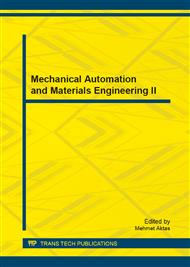p.524
p.529
p.534
p.539
p.544
p.549
p.554
p.559
p.564
The Application of Servo Motor Direct Drive Pump Control System in Pre-Bending Machine
Abstract:
Efficient and energy-saving are the development tendencies of the pre-bending machine. The new pre-bending machine is consisted of a constant pump driven by servo motor instead of common motor, variable pump and proportion valve. The advantage of this hydraulic system is energy-saving and it’s a closed-loop which controls the hydraulic system. In order to get different flow, it needs to adjust the servo motor speed by the control unit. This hydraulic system not only has a good performance, but also can significantly reduce energy consumption.
Info:
Periodical:
Pages:
544-548
Citation:
Online since:
June 2014
Price:
Сopyright:
© 2014 Trans Tech Publications Ltd. All Rights Reserved
Share:
Citation:


